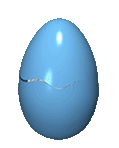 A shield-toothed horse-dragon may sound like a fabulous creature, but the newly described dinosaur once roamed the U.S. West, a new study says.
A shield-toothed horse-dragon may sound like a fabulous creature, but the newly described dinosaur once roamed the U.S. West, a new study says.The 125-million-year-old herbivore Hippodraco scutodens whose partial skull and bones were unearthed in 2004 in eastern Utah has a long, low skull like a horse's and a mouth filled with shield-shaped teeth.
Hippo and draco are Latin for "horse" and "dragon," respectively, while scutum means "oblong shield" and dens means "tooth."
Also revealed newly, fossils of another newly described species from the same time period, Iguanacolossus fortis, were found in 2005 not far from Hippodraco.
That "ponderous beast" is named for its comparatively large size—about 30 feet (9 meters) long, compared with Hippodraco's 15 feet (4.5 meters), according to the study.
Iguanacolossus's teeth look like those of Iguanodon, a related, 33-foot (10-meter) North American herbivore that likely lived a few million years before Hippodraco.
Both of the newfound dinosaurs are iguanodonts, an "tremendously successful" group of plant-eaters that expanded worldwide during the early Cretaceous period, the study team wrote.
Despite their abundance, North American iguanodonts from this period are rare in the fossil record except in one Utah rock formation, which spans about 40 million years and contains fossils of many types of creatures, according to study leader Andrew McDonald, a graduate student at the University of Pennsylvania.
"They're part of this actually interesting window into the early Cretaceous that's been emerging in western North America during the past two decades," McDonald said.
"They're filling in another chapter of what will ultimately be a complete and intricate story."




















